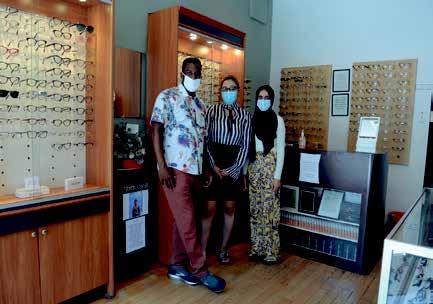HEALTH
HARLEM COMMUNITY NEWSPAPERS
Disparities in Triple Negative Breast Cancer Rutgers Cancer Inst. Expert Explains Triple Negative Breast Cancer Among African American Women
T
riple-negative breast cancer (TNBC) is a subtype of breast cancer that is aggressive by nature with a complex biology. Studies have shown a high prevalence of triple-negative breast cancer among younger African American women and those of African descent. Coral Omene, MD, PhD, medical oncologist at Rutgers Cancer Institute of New Jersey whose clinical expertise focuses on triple negative breast cancer and other forms of breast cancer, translational research and clinical trials, shares more on this topic. What is triple negative breast cancer? TNBC does not possess the estrogen receptor, progesterone receptor, and human epidermal growth factor 2 receptor. Most
breast cancers are classified by these three proteins, which guides treatment management. Since triple-negative breast cancer does not have any of these receptors, it tends to be more challenging to treat. Women with TNBC have a high frequency of metastasis to the lungs, liver and brain leading to poor survival. Compared to other subtypes of breast cancer, there has been a lack of effective therapies, resulting in a poor prognosis. This is particularly true for young African American women and women of African descent. Not only is there a higher prevalence of TNBC in these women, they tend to present at a more advanced stage. Notably, compared with other subtypes, they have
different risk factors for this disease. For instance, younger age, premenopausal status, having more children, not breastfeeding or shorter duration of breast feeding, and obesity are all risk factors. Interestingly, most of these are typically the opposite of the risk factors associated with developing breast cancer. The increased risk for this population as well as for women of African descent (in particular from West Africa and sub-Saharan Africa) suggests genetic components of geographically defined African ancestry may be associated with hereditary susceptibility for specific patterns of breast cancer development. There are multiple factors besides presenting to the clinic at a more advanced stage that contribute to worse
clinical outcomes for African American women with this disease. They include health care access barriers, one or more underlying medical conditions, income disparities and experiences of societal inequality. There has been ongoing research in this area at Rutgers Cancer Institute of New Jersey from multiple investigators. To highlight a few areas of personal interest, I have been working on a translational project modifying
the risk for developing triple negative breast cancer in a TNBC mouse model. Currently, in collaboration with several researchers at Rutgers Cancer Institute, I am investigating the alterations in the genomic landscape of African American Women with TNBC and investigating the association of obesity in these women and responses to therapy. I am also a member of the Center for Cancer Health Equity in partnership with the Rutgers School
of Public Health which works to evaluate clinical trial enrollment, address catchment area burden and foster catchment area and disparities research. It is essential that we understand the potential molecular mechanism(s) by which biology and disparities may interconnect to result in aggressive TNBC development in African American women. This may lead to the development of models that determine specific risk, increase access to early detection, care and clinical trial participation, in addition to the implementation of health policies to eliminate disparities. The Carolina Breast Study; Women’s Circle of Health Study, Newman and Kaljee, JAMA Surg 2017; Dietze E et al., Nature Reviews, 2015; Xing CY et al, Cancer Epidemiol Biomarkers Prev, 2020.
Shop Smart This October to Benefit Breast Cancer Patients Harlem Community Newspapers | October 15. 2020
(Statepoint)
12
I
t is not always easy to tell how your charitable dollars are going to be used, especially during National Breast Cancer Awareness Month. Honored every October, this is a time of year when many companies use pink logos on product packaging to symbolize support for breast cancer-related charities. Unfortunately, these symbols are not always backed by a promise that proceeds will directly support research or those living with breast cancer. In the case of Susan G.
PHOTO SOURCE: Courtesy of Susan G. Komen
Komen and its Live Pink program, the organization works closely with all its partners to ensure program details are transparent to consumers. And this year, 18 companies are donating a percentage of the proceeds from the sale of se-
lect products to Komen. As many consumers are doing much of their shopping online these days, Komen has created a site that makes it easy and safe to shop for a cause. Visit livepink.org to shop and learn more. “It just takes a moment
to get involved and make a difference in the fight against breast cancer,” says Sarah Rosales, vice president of Corporate Partnerships, Susan G. Komen. “We’re honored to have so many partners giving consumers an opportunity to support breast cancer patients and fund lifesaving research.” Want to ensure you are making the biggest impact possible? Before making any purchase you assume benefits the fight against breast cancer, Susan G. Komen recommends asking the following questions: 1. Who is the program
supporting? Is it clear what charity is benefiting from the program? Susan G. Komen, for example, requires all of its partners to clearly state that their program benefits the organization. In many cases, they will include Komen’s iconic logo on their packaging. 2. How will the charity use the donation? It should be clear where the proceeds go. Look for programs that support organizations which take a 360-degree approach to fighting the disease by funding breakthrough research, supporting compassionate public
policy and providing patient support. 3. How is the program structured? Transparency is key. Is the company clearly stating how the money is raised and how much will be going to charity? For example, if it’s a donation per purchase structure, ask how much of the purchase price benefits the charity. Is there is a minimum or maximum contribution? Is it a flat donation regardless of sale? By shopping savvy this National Breast Cancer Awareness Month, you can ensure your purchases are making the biggest impact possible.









